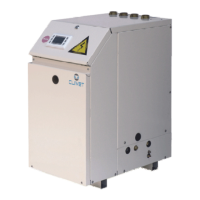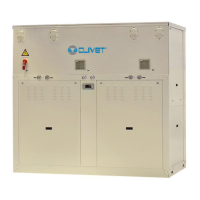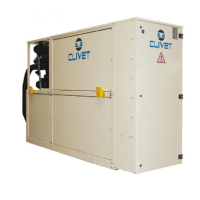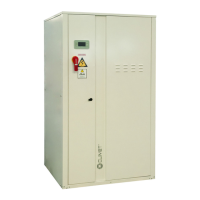M03Q40G6-03 30/07/08 pag 5
INSTRUCTIONS FOR THE USER
• This is a partial sintex of the information provided in the manual; carefully read this manual
• Carefully read this manual. Keep it with the electrical diagram. Make it available to technicians for servicing.
• Ask the installer for training on start-up, shutdown, changing set points, placing in at-rest status, maintenance, what to do
or not to do in the event of a breakdown.
• Provide for scheduled maintenance by specialized technicians so as to ensure long-lasting operation of the unit.
• If you expect the machine to be shut down for long periods of time, disconnect the electrical power supply. In winter, take
necessary measures to deal with possible freezing (unit and system pipes) .
REFRIGERANT CYCLE : PRINCIPLE OF OPERATION
SUMMER: the cooling cycle allows the transfer of excess indoor heat to the
external environment:
1. The compressor compresses the refrigerant gas, placing it at high
pressure and high temperature;
2. in the source side exchanger the refrigerant is cooled and the heat is
released in the environment ; depending on the type of system, the
disposal occurs using one of the following systems:
3. horizontal geothermal probes placed in the ground at a depth of about
1.5 m
4. vertical geothermal probes (from a depth of 30 to 100 m)
5. groundwater collector/disposal wells;
6. When it cools, the refrigerant becomes liquid;
7. The expansion valve causes a sudden drop in the pressure of the
refrigerant, which becomes very cold as its volume increases;
8. in the utility-side exchanger, the refrigerant evaporates and absorbs
heat from the water that returns from the equipment (underfloor piping -
fan coil), cooling it
9. the refrigerant at gaseous status is sucked up by the compressor and the
cycle is repeated
2
1
3
4
5
6
7
8
9
WINTER only WSHH: the cooling cycle makes it possible to absorb energy
(heat at low temperature) from the external environment and to transfer it to
the area to be heated.
1. The compressor compresses the refrigerant gas, placing it at high
pressure and high temperature;
2. in the utility-side plate exchanger the water that returns from the
equipment (underfloor piping – fan coil – bathroom fixtures) absorbs heat
from the refrigerant and heats up;
3. When it cools, the refrigerant becomes liquid;
4. The expansion valve causes a sudden drop in the pressure of the
refrigerant, which becomes very cold as its volume increases .
5. in the source-side exchanger the cold refrigerant evaporates and absorbs
heat from the external environment through
6. vertical geothermal probes
7. horizontal geothermal probes
8. collector well
9. the refrigerant at gaseous status is sucked up by the compressor and the
cycle is repeated
1
2
3
4
5
6
7
8
9
WATER CIRCUIT
The diagram on the side is indicative and includes optional components; check
with the installer about the system configuration used.
1. fan coil;
2. if the room needs to be heated, the 3-way valve diverts the water towards
the underfloor piping (all or in part); if instead the underfloor piping is
satisfied, it returns the water directly to the unit;
3. the pump keeps the water in circulation in the underfloor piping
4. radiant panels
5. the pump returns the water to the unit
8
1
2
3
4
5

